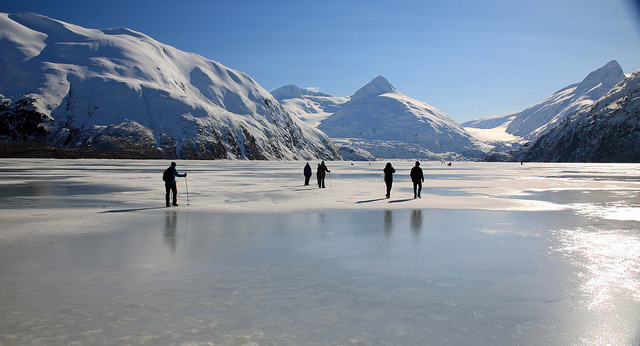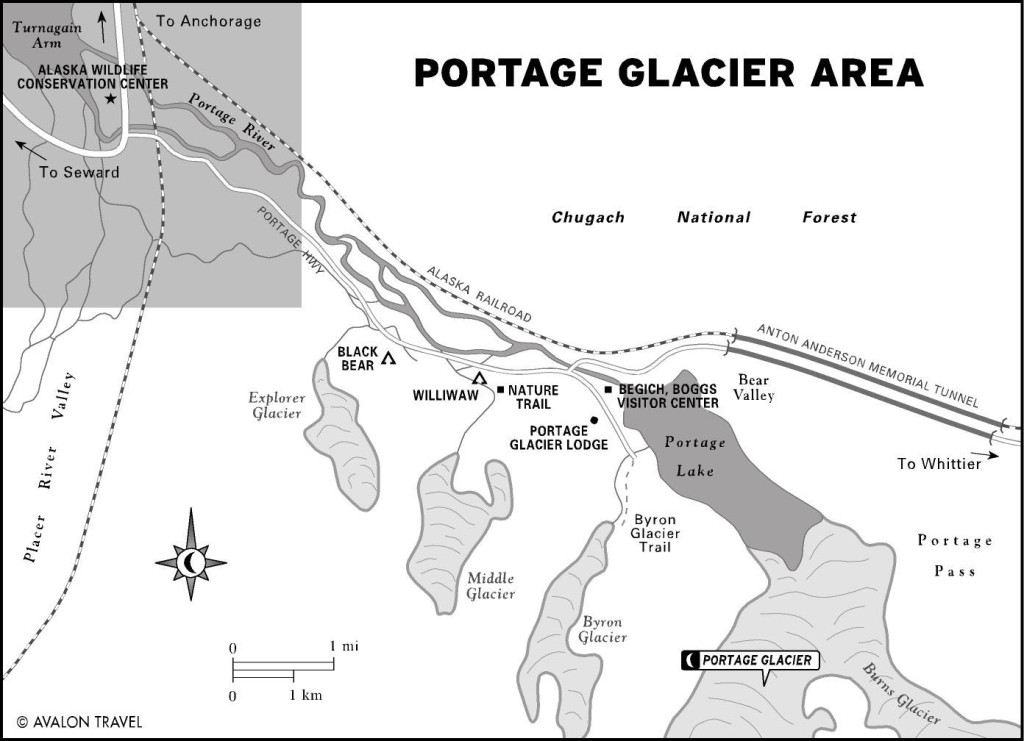
Hikers crossing frozen Portage Lake to see the Glacier. Photo © Frank Kovalchek, licensed Creative Commons Attribution.
Fifty miles south of Anchorage on the Seward Highway is the turnoff to Portage Glacier and Whittier. A six-mile access road takes you through Portage Valley to Portage Glacier. A town that stood on this corner was destroyed when the 1964 earthquake dropped the land 6–10 feet. Saltwater from Turnagain Arm inundated the area, killing the still-standing trees; the remaining buildings are gradually disintegrating. Portage Glacier is one of the more popular tourist attractions in Southcentral Alaska, so be ready to share the ride with busloads of cruise ship travelers.An info booth along the Seward Highway has details on Whittier, and it sells tickets for various tour options, including the Alaska Railroad’s scenic trips to Grandview.

Portage Glacier Area
The Forest Service’s Begich, Boggs Visitor Center (907/783-2326, daily 9 a.m.–6 p.m. late May–Sept., Sat.–Sun. 10 a.m.–5 p.m. Oct.–late May) is named after Nicholas Begich (U.S. representative from Alaska and father of current U.S. Senator Mark Begich) and Hale Boggs (majority leader of the U.S. Senate and father of journalist Cokie Roberts), whose plane disappeared in the area in 1972. They were never found. A large picture window overlooks the narrow outlet of Portage Lake. When the visitor center first opened, the glacier was readily visible, but it is now out of sight around a corner, and in recent years the number of icebergs entering the lake has decreased greatly as it continues to shrink.
The visitors center boasts an amazing array of displays, including an ice cave, a small iceberg hauled in from the lake, an engrossing relief map of local ice fields, and everything you ever wanted to know about glaciers, including displays on glacial motion and crevasses. Don’t miss the vial of tiny iceworms, which inhabit the surfaces of glaciers, feeding on pollen grains and red algae and surviving within a delicate, near-freezing temperature range. There’s also good footage of iceworms in the 20-minute movie Voices from the Ice (shown every hour, $3).
During the summer, Forest Service naturalists lead half-mile nature walks. The observation platform near Williwaw Campground is a good place to see spawning red and chum salmon in late summer.
To see Portage Glacier, you’ll need to hop onboard the 200-passenger Ptarmigan tour boat; catch it at the dock near the visitors center. Operated by Gray Line of Alaska (907/277-5581 or 888/452-1737), these one-hour cruises across Portage Lake cost $29 and start at 10:30 a.m., with the last tour at 4:30 p.m. This boat tour, plus round-trip bus transportation from Anchorage (includes a stop at Alyeska) costs $75 on Gray Line.
Two hikes are within walking distance of the visitors center. The Moraine Loop Trail, accessible from the path to the lodge, is a five-minute stroll through typical moraine vegetation; Portage Glacier occupied this ground only 100 years ago. Follow the access road past the visitors center (south) just under a mile. At the back of the parking lot starts the Byron Glacier Trail, an easy 0.75-mile walk along the runoff stream to below this hanging glacier.
Two Forest Service campgrounds ($14) near Portage contain woodsy sites: Black Bear Campground and the larger Williwaw Campground. The latter has summertime campfire programs on Saturday evenings and a wheelchair-accessible observation platform where spawning salmon are visible in the summer. Williwaw’s sites can be reserved (518/885-3639 or 877/444-6777,).
This 140-acre game farm (907/783-2025, $10 adults, $8 children and seniors, maximum $30 per vehicle) sits along Turnagain Arm just across the Seward Highway from the turnoff to Portage Glacier. Open daily all year, this nonprofit center for orphaned and injured Alaskan animals has grizzly and black bears, bison, moose, elk, musk oxen, deer, and caribou.
Excerpted from the Tenth Edition of Moon Alaska.